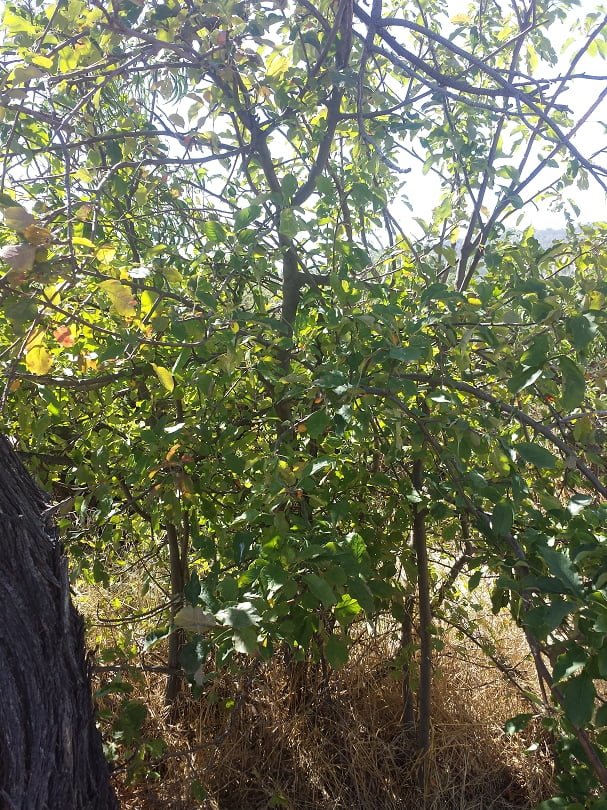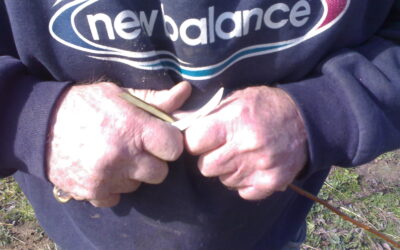Estimated reading time: 6 minutes
This is a very common question from enthusiastic gardeners excited to grow their own trees. The answer is very simple—yes.
Trees grown this way are called seedlings. They are quite different from trees grown on vegetative rootstocks, such as dwarf fruit trees.
However, the more interesting question is, “Will a seedling apple tree bear edible fruit?”
This is much harder to answer—it’s “maybe”—and depends on sheer chance.
How do apple trees reproduce?
Apple trees are surprisingly like people!
The seeds inside an apple are a genetic mix of its parents (just like people). The fruit they grow will be a random genetic mixture of the tree it grew on and whichever apple tree pollinised it.
Just like children in a family may be completely different from each other, every seedling apple tree will vary.
This is important to understand if you’re trying to figure out what type of tree you have. For example, you might have moved into a house with existing fruit trees and you don’t know their history.
Maybe you have an apple tree that doesn’t produce fruit or fruit that’s not very nice. It’s a situation that arises frequently for our Grow Great Fruit members.
There’s a good chance that the original homeowner (or whoever planted the tree) won’t have kept good records or labels. As a new resident, this makes it tricky to know what you’re dealing with. So, you’ll probably need to do some garden detective work to figure out what you’ve got.
How to tell the difference between an apple tree that’s grown from a seed and a grafted tree
First up, you need to look at whether the tree is grafted or a random apple tree that’s grown from seed.
Not sure of the difference?

Here are a couple of tips that might help:
Look for a graft union, where the scion was grafted onto the rootstock.
Any fruit tree you buy from a nursery will have been grafted unless you’re buying rootstocks from a specialist rootstock nursery.
Unfortunately, the graft union may be hard to see in the adult tree. If you can see it (there are a couple of examples in the photos above and below) – great! You know you’ve got a grafted tree, which means it’s a known variety. Then you can start trying to figure out which one and look for other reasons why it might not be bearing fruit.
Unfortunately, not being able to see a graft union is inconclusive evidence. It may be a seedling, or it may be a grafted tree where the union is no longer visible.

Another give-away is a tree having multiple trunks.
Seedlings are often naturally multi-trunked, while grafted trees always start with a single trunk.
It’s very common (particularly if a tree hasn’t been well looked after) to see the original grafted trunk plus a number of suckers from below the graft union that have become extra trunks.
One way to spot this is to note whether seasonal changes (e.g. blossom, or leaves changing colour in autumn) look the same and happen at the same time on each trunk. Also, check whether they all bear the same type of fruit (or any fruit at all).

Celebration of the seedling in America
Traditionally in Australia, seedlings have been thought of only as a source of rootstocks for grafting known varieties onto. Seedlings themselves have been considered at best worthless, and at worst pest trees that must be chopped down and eradicated.
We noticed a much different approach to seedling apple trees when we visited America. In Maine, we visited the Maine Organic Farmers and Gardeners, which must be the apple-nerd capital of the world. At MOFGA, seedlings are more likely to be appreciated for their own potential.

“A seedling apple is like a musical improvisation In the world of music, one parent would be the original composition and the second would be the musician. When the musician sets aside the printed page and plays the tune extemporaneously, the result is something new….You may or may not recognise the tune. It may be pleasant to the ear, or it may be discordant. Musical improvisations may be endlessly fresh and inventive…they may also be stale, cliche and uninteresting. However, whether you like them or not…each will be new and unique.
Same with apples. Some seedlings will be stale and uninteresting, while others will be quite wonderful. Each is an improvisation.“
John Bunker, Apples and the Art of Detection

From “Apples and the Art of Detection”, by John Bunker
Does it matter if an apple tree is grafted or grown from seed?
So, if a seedling tree is potentially a wonderful fruit tree in its own right, why does it matter if your tree is a seedling or a grafted tree?
Because (as John points out), “some seedlings will be stale and uninteresting”. In other words, the fruit they produce is not nice to eat, which makes the trees useless.
Grafted varieties however have all been chosen because they’ve been proven to grow apples with desirable characteristics.
If you’re aiming for fruit self-sufficiency (and if you’ve got room for a few trees, why wouldn’t you be?) then each tree needs to pull its weight by growing the varieties and quantities of fruit you want.
So if you want to achieve fruit self-sufficiency, you need to know what you’re starting with. There’s no room in a productive and thriving food production garden for “stale and uninteresting” fruit!
Related Articles
A good grafting knife…
A good grafting knife (and knowing how to keep it sharp) sets you up for grafting success as much as the techniques you need to master.
How to plant a fruit tree – the easy way
Everything you need to know about how to plant your new fruit trees to get them off to a great start in life.
How to buy a good fruit tree
Learn how to select a healthy fruit tree when you’re buying from a nursery, to give your trees the best possible start in life.








Love your info…your comment… put sticky bands around your fruit trees?? what are they and where do I get them? What do I ask for? many thanks. Maureen
Hi Maureen – you can either buy horticultural glue (various brands), or find a double-sided stick tape (e.g. Greenharvest sell a version) or improvise! If you use grease or something similar, just wrap a layer of clingwrap or something like that around the trunk of the tree first to make a barrier (and be aware that it might melt in really hot weather and need replacing).
Seedling trees are a potential waste of space but who can resist trying the fruit just in case? As a cyclist who likes to roam along roadside and rail it’s amazing what can be found. Apricots in the middle of nowhere from a pip or two thrown potentially decades before. Apples in cooler climes. Pears are much harder to find with fruit. They seem to revert to wild prickly stock much more readily than apples, have a longer juvenile period and maybe lack a nearby pollinator. Plums, too, are worth checking, especially early in the season. Just by chance you may come across something really special. Like the large stripey red, juicy apple I found late one April, off a roadside but close enough to the farmer’s boundary fence that the local sheep were in waiting for the fruit to fall. Better than Delicious, and reminiscent of flavours that have vanished or been banished from commercial shelves.
What a fantastic find Alex. If you were to get some wood from that tree you could graft it onto a tree closer to home, and have access to the apples all the time!